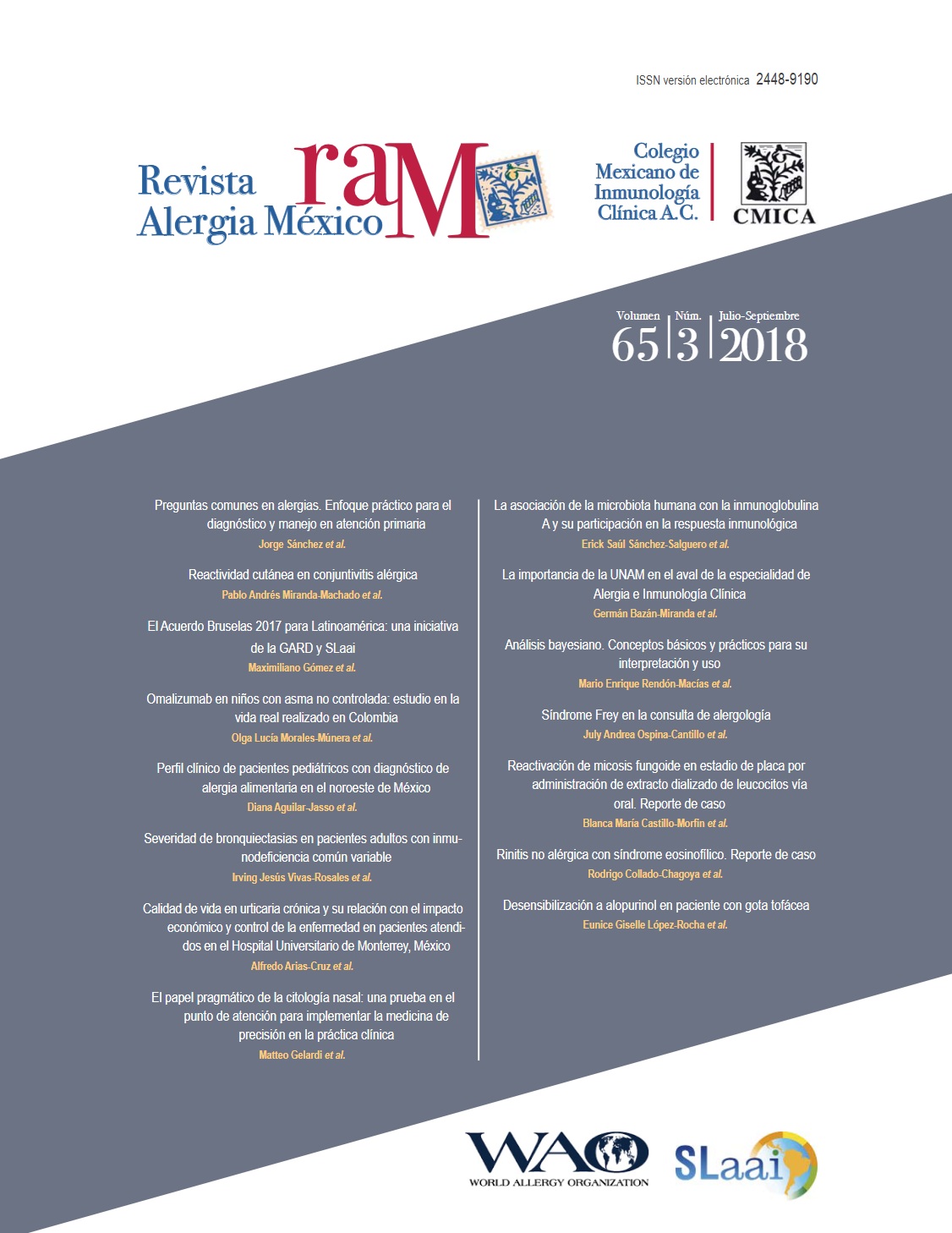Abstract
Background: Mycosis fungoides is a cutaneous T-cell lymphoma. The patch stage is limited to the skin and may spontaneously involute or progress, spreading to peripheral blood, lymph nodes and viscera.
Case report: 64 year-old female with a 6-year history of dermatosis with scaly, poorly delimited and pruritic plaques on the chest and extremities. She had received oral steroids and antihistamines, with transient partial remissions been experienced. Skin biopsy revealed Pautrier’s microabscesses, which are pathognomonic of mycosis fungoides. Positron-emission tomography and peripheral blood smear ruled out dissemination and confirmed patch-stage mycosis fungoides. She received nitrogen mustard topical derivatives, psoralen plus UVA therapy, steroids and tacrolimus. She achieved complete remission at 6 months. Two years later, she was treated with dialyzable leukocyte extract, which reactivated the patch lesions with severe itching; the extract was discontinued. The lesions resolved two weeks after topical clobetasol was applied.
Conclusions: Th2 predominates in mycosis fungoides. Given that dialyzable leukocyte extract reinforces the Th1 profile, it was unlikely for it to reactivate the disease, but the diversity of lymphocyte immunophenotypes in mycosis fungoides and the complex activation networks caused a paradoxical reactivation.
References
Zinzani PL, Ferreri AJM, Cerroni L. Mycosis fungoides. Crit Rev Oncol Hematol. 2008;65:172-181. DOI: 10.1016/j.critrevonc.2007.08.004
Kim EJ, Hess S, Richardson SK, Newton S, Showe L, Benoit BM, et al. Immunopathogenesis and therapy of cutaneous T cell lymphoma. J Clin Invest. 2005;115(4):798-812. DOI: 10.1172/JCI24826
Jahan-Tigh RR, Huen AO, Lee GL, Pozadzides JV, Liu P, Duvic M. Hydrochlorothiazide and cutaneous T cell lymphoma: prospective analysis and case series. Cancer. 2013;119(4):825-831. DOI: 10.1002/cncr.27740
Aschebrook-Kilfoy B, Cocco P, La-Vecchia C, Chang ET, Vajdic CM, Kadin ME, et al. Medical history, lifestyle, family history, and occupational risk factors for mycosis fungoides and Sézary syndrome: the Interlymph non-Hodgkin Lymphoma Subtypes Project. J Natl Cancer Inst Monogr. 2014;2014(48):98-1095. DOI: 10.1093/jnclmonographs/lgu008
Litvinov IV, Shtreis A, Kobayashi K, Glassman S, Tsang M, Woetmann A, et al. Investigating potential exogenous tumor initiating and promoting factors for cutaneous T-cell lymphomas (CTCL), a rare skin malignancy. Oncoimmunology. 2016;5(7):e1175799. DOI: 10.1080/2162402X.2016.1175799
Schmidt-Skrabs CC. Pautrier microabscesses (PA): a historical note. Am J Dermatopathol. 2000;22(6):555.
Bunn PA, Lamberg SI. Report of the committee on staging and classification of cutaneous T-cell lymphomas. Cancer Treat Rep. 1979;63(4):725-728.
Guenova E, Watanabe R, Teague JE, Desimone JA, Jiang Y, Dowlatshahi M, et al. Th2 cytokines from malignant cells suppress Th1 responses and enforce a global Th2 bias in leukemic cutaneous T cell lymphoma. Clin Cancer Res. 2013;19(14):3755-3763. DOI: 10.1158/1078-0432.CCR-12-3488
Berger CL, Hanlon D, Kanada D, Dhodapkar M, Lombillo V, Wang N. et al. The growth of cutaneous T-cell lymphoma is stimulated by immature dendritic cells. Blood. 2002;99(8):2929-2939. DOI: 10.1182/blood.V99.8.2929
Litvinov IV, Cordeiro B, Fredholm S, Odum N, Zargham H, Huang Y, et al. Analysis of STST4 expression in cutaneous T-cell lymphoma (CTCL) patients and patients derived cell lines. Cell Cycle. 2014;13(18):2975-2982. DOI: 10.4161/15384101.2014.947759
Chang TP, Vancurova I. NFB function and regulation in cutaneous T-cell lymphoma. Am J Cancer Res. 2013;3(5):433-445.
Luna-Hernández J, García-Rodríguez L. Aspectos inmunológicos de la fototerapia. Rev Soc Peruana Dermatol. 2011;21(3):109-115. Disponible en: http://sisbib.unmsm.edu.pe/BVRevistas/dermatologia/v21_n3/pdf/a03v21n3.pdf
Kirkpatrick CH. Transfer factor. J Allergy Clin Immunol. 1988;81(5 Pt 1):803-813. Disponible en: https://www.jacionline.org/article/0091-6749(88)90935-9/pdf
Kirkpatrick CH. Transfer factors: identification of conserved sequences in transfer factor molecules. Mol Med. 2000;6(4):332-341. Disponible en: https://www.ncbi.nlm.nih.gov/pmc/articles/PMC1949950/pdf/10949913.pdf
Ojeda MO, Van’t-Veer C, Fernández-Ortega CB, Araña-Rossainz MJ, Buurman WA. Dialyzable leukocyte extract differentially regulates the production of TNF alpha, IL-6 and IL-8 in bacterial component-activated leukocytes and endothelial cells. Inflamm Res. 2005;54(2):74-81. DOI: 10.1007/s00011-004-1326-5
Franco-Molina MA, Mendoza-Gamboa E, Castillo-Leon L, Tamez-Guerra RC, Rodríguez-Padilla C. Bovine dialyzable leukocyte extract modulates the nitric oxide and pro-inflammatory cytokine production in lipopolysaccharid estimulated murine peritoneal macrophages in vitro, J Med Food. 2005;8(1):20-26. DOI: 10.1080/14653240701320262
Hernández ME, Mendieta D, Pérez-Tapia M, Bojalil R, Estrada-García I, Estrada-Parra S, et al. Effect of selective serotonin reuptake inhibitors and immunomodulator on cytokine levels: an alternative therapy for patients with major depressive disorder. Clin Dev Immunol. 2013;2013:267871. DOI: 10.1155/2013/267871
Homberg T, Sáenz V, Galicia-Carreón J, Lara I, Cervantes-Trujano E, Andaluz MC, et al. The adverse event profile in patient treated with Transferon™ (dialyzable leukocyte extracts): a preliminary report. Pharmacology & Pharmacy. 2015;6:65-74. DOI: 10.4236/pp.2015.62009
Zackheim HS. Treatment of patch-stage mycosis fungoides with topical corticosteroids. Dermatol Ther. 2003;16(4):283-287.

This work is licensed under a Creative Commons Attribution-NonCommercial 4.0 International License.
Copyright (c) 2018 Revista Alergia México

